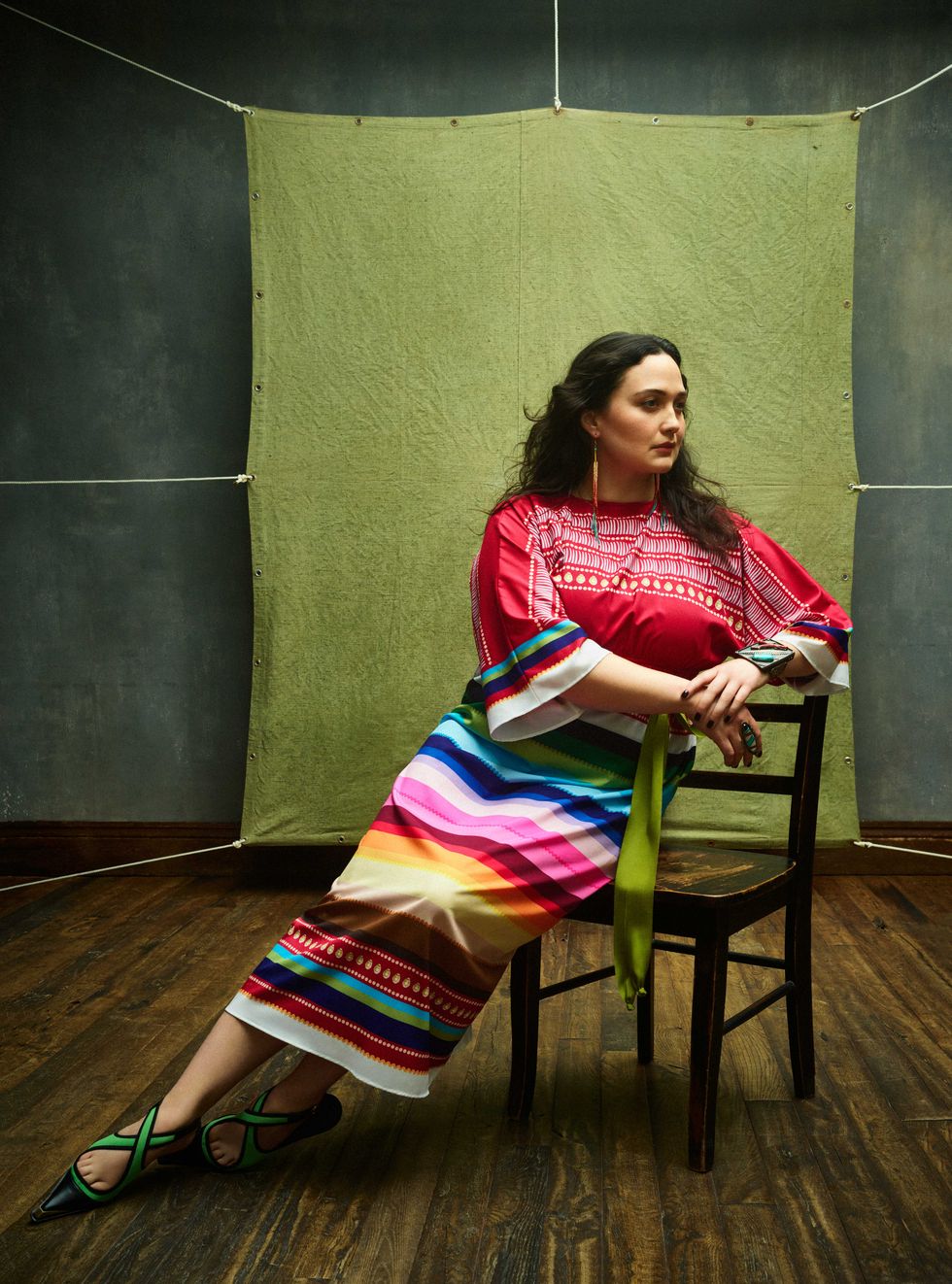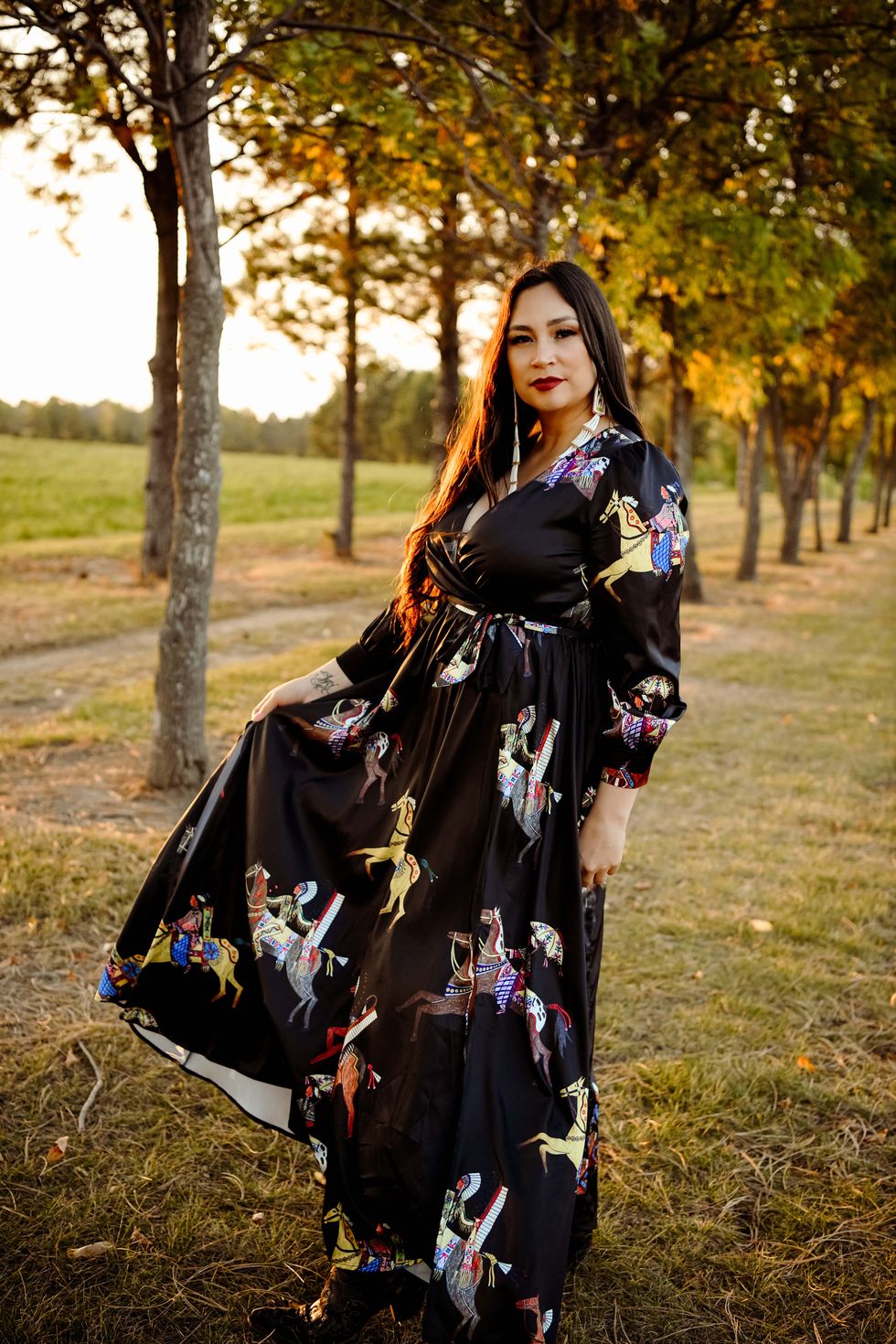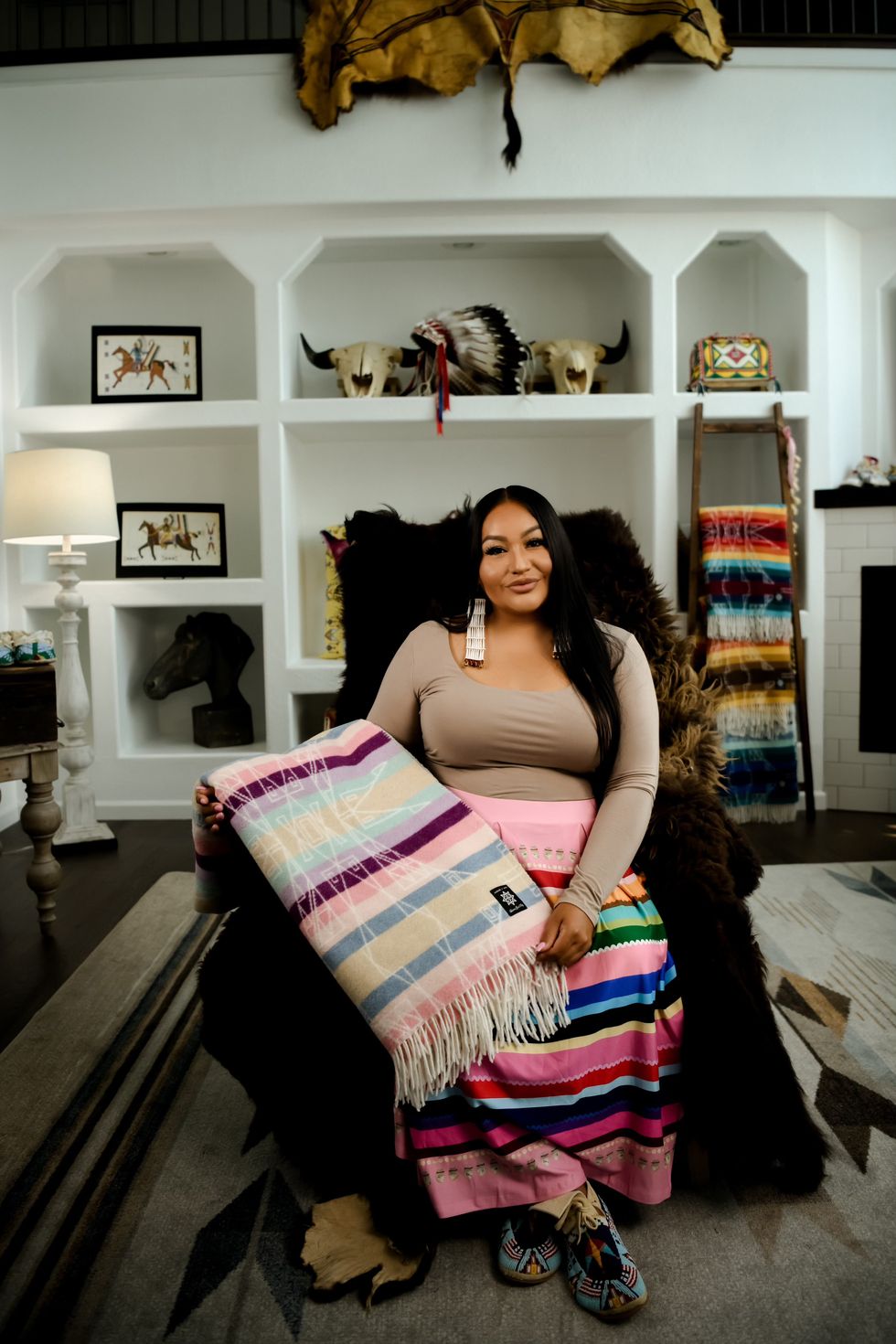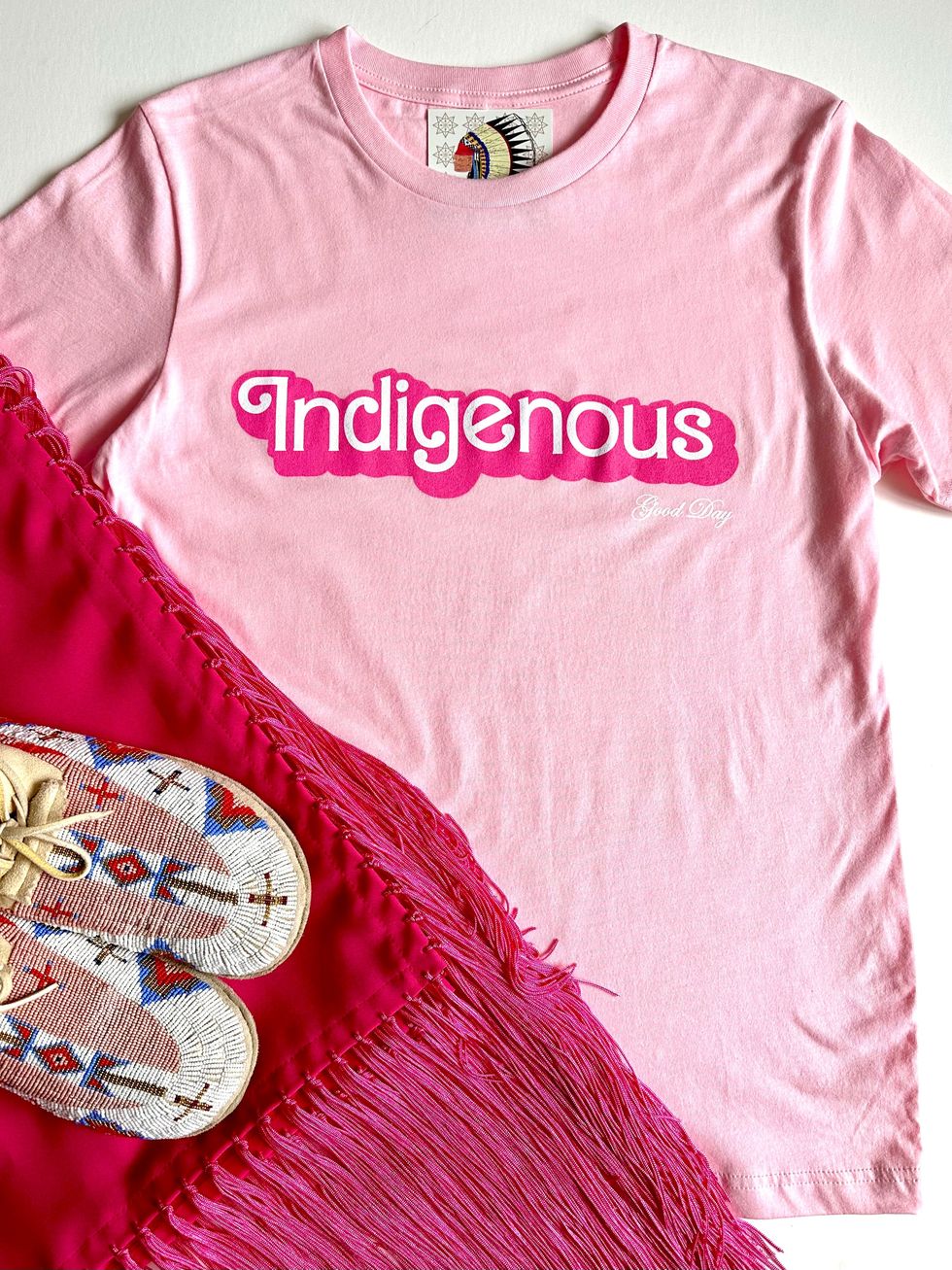Lauren Good Day Blends Traditional With Contemporary
Style Points is a weekly column about how fashion intersects with the wider world.
“If you want to see the best Native American fashion, go to a grand entry at a powwow,” says designer Lauren Good Day. She’s quoting something she heard once, but it’s a fitting motto, given that it’s where the North Dakota-based designer got her start. After being selected as a powwow princess at age 13, she declared her intention to become a fashion designer in her official bio. Later in her teens, she went on to design tribal regalia for the events.
Good Day—who is Arikara, Hidatsa, Blackfeet, and Plains Cree—comes from a long line of women who created handmade garments for their families; her first inkling of fashion came when her mother taught her how to bead at age six. Now, she’s parlayed that tradition into a thriving fashion business. A recent highlight: providing a look for Killers of the Flower Moon star Lily Gladstone, featured in ELLE’s Women in Hollywood portfolio for the December 2023/January 2024 issue.
Good Day’s creations are deeply personal. Gesturing to the sweater she’s wearing during our interview, the 36-year-old designer shows me how it features a beaded recreation of her daughter’s cradle. The intricate handwork took Good Day three months to complete; she would work on it every night after her kids went to sleep, and finished it the day before her daughter was born.
Ledger art, a Native art form with roots in the Plains region, is another influence on her designs. “It was basically an art form of adaptation,” she explains. “Historically, we would paint our stories and record our histories on buffalo robes, but once we got put on the reservations, we no longer had access to the buffalo robes. So we used what was readily available, which happened to be paper, sometimes receipts, from military forts, from the general stores that were around us—just anything that we could get our hands on. We would use crayons, colored pencil, sometimes pen and ink, even just regular pencil.” Though it’s a traditionally male pursuit, Good Day began practicing ledger art before becoming a fashion designer in 2019, and she’s carried the motifs into her designs. Her fall collection, for example, features ledger art-inspired prints of parade rider horses.
Good Day’s collections mix traditional pieces like this with more contemporary fare, like graphic T-shirts. She wants to demonstrate, she says, that “yes, we are these traditional people still,” adding, “We hold onto our values. We live our culture daily, yet we still exist in this contemporary world as well. Our culture can still come with us wherever we go.”
Growing up, she says, “There were Native designers, but I feel like with the power of social media now, we’re more visible. I didn’t see a lot of people wearing traditional clothing. It wasn’t on TV. It wasn’t right in front of our faces. It wasn’t when we open up our phones. But now that I’m able to put my work out there, I hope to inspire our young people and people who maybe are displaced from their Native culture, but want to appreciate it. Then also for non-Natives to appreciate our culture and the beauty of where we come from.”
The response, both from within her community and outside it, has been overwhelmingly positive. “I do get some [non-Native] people who ask me, ‘Can I wear this? Is this appropriation?’ And I say no, anything from my ready-to-wear collections, anything that I sell, is appropriate for everyone and for all to collect, buy, wear, and to love and appreciate. I would never sell anything that’s sacred. I would never sell eagle feathers. I would never sell a war bonnet. I would never create something that isn’t culturally appropriate to sell to non-Natives or to Native people.”
Fashion’s long history of appropriating Native culture isn’t lost on Good Day. But she has noticed, of late, that “even companies that in the past have appropriated Native design and iconography have [recently] taken steps to work with Native artists and designers. They’re no longer appropriating us; they’re collaborating with us.”
For ELLE’s Women in Hollywood issue, Good Day provided a piece, the Dentalium Ribbons T Dress, that carries deep significance within her culture. The garment is “based on our traditional Mandan-Hidatsa-Arikara ribbon dresses,” which were typical of “many Northern Plains tribes of the Middle Missouri region, including the Blackfeet, and were historically adorned with shells, sequins, and beads.
“I think it’s amazing that Lily is wearing my pieces, and I’m so grateful for every opportunity,” she says. “I was familiar with her work. I know that she’s a Blackfeet descendant, and I’m actually Blackfeet on my father’s side. So it was really cool to see Blackfeet in big spaces. I’m so proud of her and I love the work that she’s doing, and it’s amazing to see Native people being recognized for the work that they’re doing.” (And yes, she has seen Killers of the Flower Moon. “I think she did a phenomenal job.”)
Good Day’s work has another connection to a major 2023 film, albeit an unofficial one. Her Indigenous Barbie T-shirt has become a huge hit, and she’s already had to restock it multiple times. When the Greta Gerwig film came out this summer, Good Day says, “Barbie was everywhere. Barbie, of course, is this blonde-haired, blue-eyed, non-Native woman.” Her young daughters play with Barbies, and “I try to encourage them, with everything in life, to be proud of who they are and to find beauty in who they are and how they look. So I was like, ‘Well, you’re Barbie too. You’re Indigenous Barbie.’ And they were like, huh? I was like, ‘Watch, I’ll show you.’ So I made them these beautiful little dresses,” a project which sparked the idea for the shirt.
Would she ever work with Mattel? “I would love to. That was one of my goals when I was creating that with my girls. I know they came out with a Wilma Mankiller Barbie, and they have their nice Native Barbie, but they don’t have anyone that represents a contemporary regular Native person today. It would be so cool to see a contemporary Native Barbie with a ribbon skirt and a Lauren Good Day hoodie. Maybe she has a pair of moccasins on. I think my daughters would love to play with a Barbie like that.”

ELLE Fashion Features Director
Véronique Hyland is ELLE’s Fashion Features Director and the author of the book Dress Code, which was selected as one of The New Yorker’s Best Books of the Year. Her writing has previously appeared in The New York Times Magazine, The New Yorker, W, New York magazine, Harper’s Bazaar, and Condé Nast Traveler.







